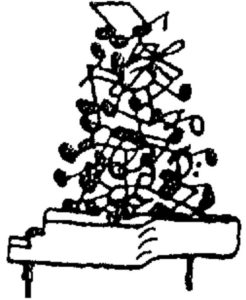A Guide for Parents, Students and Teachers for Mastering Rhythm by Metro Music Music Makers teacher J.T. Lee
So many times in lessons the student walks through an assigned piece, stumbling through all of the right pitches but seems somewhat puzzled when asked to do it again. “I played all the right notes,” they argue with a confused look on their face “Isn’t that enough to move on?”

“Unfortunately, no,” I have to reply, “because even though you hit the notes, it doesn’t sound like the song because your rhythms were off.”
The definition of music is organized sound, and that organizational system is comprised of two parts: the notes and the rhythms. The notes determine what we hear, while the rhythm determines when we hear it. The unfortunate truth is that even though we may play all the right notes, a right note at the wrong time is a wrong note. This means that as musicians, we have a responsibility to meticulously study rhythms as well as right notes to produce the correct interpretation of the music. So how can we make sure our students are carefully producing the right notes at the right time?
Parents: Have your students practice with a metronome
Students often want to rush through practice sessions, playing what they think are the right rhythms at the right tempo without ever taking time to actually count or check their speed. People like to rely on their own internal sense of time, but this can be terribly inaccurate, as anyone knows who has ever been stuck in Atlanta traffic and felt that 10 minutes on 285 was like an eternity. To combat this, use a metronome, or a “click” as it is sometimes called. The metronome keeps us honest when it comes to playing at a steady, even tempo and counting beats. It is never wrong, and is always consistent, provided it is a reliable one. Decent metronomes can be purchased on the App store, or if you need something a little more real, they usually run around $20 at the music store. My favorite app is the Pro Metronome app, because it’s easy to use and free for the basic version.
If a student has never used a metronome before, the most important thing they need to know is to count along with the clicks. Each beat should land right on a click, not before or after it. It is also helpful to use headphones, so they can hear the metronome over the music. Also, depending on the speed of the piece, the metronome can count different subdivisions (smaller parts of each beat). When using these metronomes, it can help make the music even more accurate as the student progresses into higher levels.
Students: Slow the music down
No one should try to play a piece of music at full speed right away; if they do, they often learn the rhythms wrong, causing more harm than good. Slow the metronome down and count carefully. Correct notes and rhythms are everything, and even though it may get boring at times, slow and steady does in fact win the race when it comes to consistent performance. The best musicians are the ones that take the most time to be the most accurate. A good strategy is to start learning your piece at half the tempo it’s supposed to be played. As you are able to play the notes and rhythms correctly, you can then slowly speed up the tempo of the piece. A great goal is to do the piece from start to finish three times at each speed. This takes a lot of patience, but if you approach your music this way, you’ll find yourself accomplishing things you never thought possible!
Teachers: Count, count, count. When you’re tired, count again!
Correct rhythmic interpretation comes as a result of meticulously counting each individual note and rest as they occur within the music. To ensure this a musician must ALWAYS BE COUNTING. Too many people try to “feel” the rhythms, and all this leads to is sloppy playing. Whether reading a Bach concerto or transcribing a Hendrix solo, teach students to count accurately in their heads as they play so that they can place every note at it’s exact moment. It helps to write the rhythm out so that the student can read it at first. From there have them count out loud while playing, if possible with their instrument. Even though this may seem confusing at first, just like everything else in music, the more they practice, the easier it becomes. An emphasis on counting will make your job easier in the future, as the student becomes more accustomed to counting even the hardest of rhythms
Though correct timing, counting, and rhythm interpretation is tough at first, students that endure a prolonged focus on it always seem to do better at competitions, auditions, and festivals. In fact it was recently stated that if a student were to try out for the GMEA district audition and on their sight-reading only play the correct rhythm on a single note, they would be awarded 15 out of the maximum 30 points. Students who attempt to do both and yet do so unsuccessfully usually score around 10 points. This week instead of just playing through the music, think about investing in a metronome to clear up rhythms and clean up your students’ playing. it may be difficult at first, but in the long run it will help set a student apart from every other musician their age.
